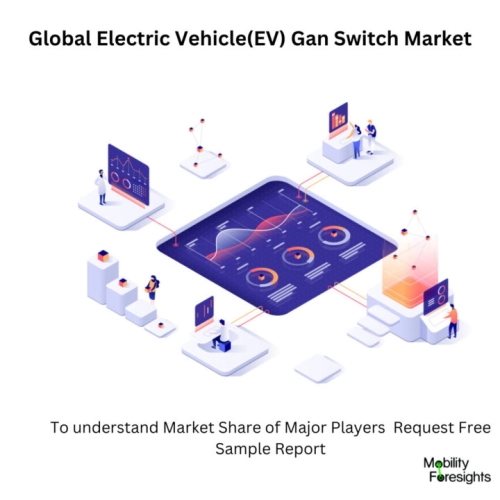
- Get in Touch with Us

Last Updated: Apr 25, 2025 | Study Period: 2024-2030
The rapid advancement of electric vehicle (EV) technology has led to the demand for highly efficient and compact power electronic systems. In this pursuit, the integration of Gallium Nitride (GaN) switches has emerged as a promising solution. EV GaN switches, based on the wide-bandgap semiconductor material Gallium Nitride, are specifically designed to optimise the performance of power electronics in electric vehicles.
With their superior properties and capabilities, these switches offer numerous advantages over traditional silicon-based counterparts. This article explores the concept of EV GaN switches, their key advantages, and their impact on enhancing the efficiency and overall performance of electric vehicles.
Advantages of EV GaN Switches:Higher Efficiency: GaN switches exhibit lower conduction and switching losses compared to conventional silicon-based switches. This results in improved overall system efficiency in electric vehicles.
The lower losses reduce heat generation, enabling more efficient energy conversion and minimising energy wastage. As a result, EV GaN switches contribute to extending the driving range of electric vehicles and reducing the energy consumption.
Faster Switching Speeds: GaN switches have inherently fast switching speeds, enabling them to switch on and off rapidly. This characteristic is crucial in power electronics, as it allows for higher switching frequencies.
The ability to operate at higher frequencies enables the design of more compact and lightweight power electronic systems. EV GaN switches facilitate the development of smaller, lighter, and more efficient power conversion systems in electric vehicles.
High Power Density: The superior properties of GaN material, such as its high breakdown voltage and electron mobility, enable the design of GaN switches with higher power ratings in smaller form factors.
This high power density translates into smaller and lighter power electronic components in electric vehicles. By reducing the size and weight of power electronic systems, EV GaN switches contribute to improving the overall vehicle efficiency and creating more space for other vehicle components.
Enhanced Thermal Management: GaN switches have excellent thermal conductivity, allowing for efficient dissipation of heat generated during operation. This characteristic minimises the risk of overheating and enables reliable operation even in demanding conditions. The improved thermal management provided by EV GaN switches increases the reliability and lifespan of power electronic systems in electric vehicles, reducing maintenance and replacement costs.
Compatibility with Wide Voltage Range: GaN switches can handle high voltages, making them suitable for various voltage levels found in electric vehicle power electronics. Whether it is the high-voltage battery pack or the low-voltage control circuits, EV GaN switches can operate seamlessly across different voltage ranges. This flexibility simplifies the design and integration of power electronic systems in electric vehicles.
In conclusion, EV GaN switches in comparison to conventional silicon-based switches offer substantial advantages. The performance and overall efficiency of power electronic systems in electric vehicles are being improved thanks to their increased efficiency, quicker switching rates, high power density, improved thermal management, and compatibility with a wide voltage range.
The usage of EV GaN switches is anticipated to rise with the continuous development of GaN technology, paving the way for the future creation of more effective and environmentally friendly electric vehicles.

The Global Electric Vehicle(EV) GaN Switch market accounted for $XX Billion in 2023 and is anticipated to reach $XX Billion by 2030, registering a CAGR of XX% from 2024 to 2030.
Power Integrations, a pioneer in high-voltage integrated circuits (ICs) for energy-efficient power conversion, recently revealed a 900-volt expansion to the InnoSwitch3TM family of flyback switcher ICs using gallium nitride (GaN).
The new ICs, which use the business's own PowiGaNTM technology, enable up to 100 watts of power to be delivered with better than 93 percent efficiency, doing away with the requirement for heat sinks and streamlining the design of applications with limited space. The remarkable light-load efficiency of InnoSwitch3 designs makes them perfect for supplying auxiliary power in electric vehicles during low-power sleep modes.
The 900-volt PowiGaN switch provides higher power and increased design marginârequired for 12-volt battery-replacement systemsâwith improved efficiency over silicon-based converters, making it an especially good fit for electric vehicles (EVs) based on 400-volt bus systems.
| 1 | Market Segmentation |
| 2 | Scope of the report |
| 3 | Abbreviations |
| 4 | Research Methodology |
| 5 | Executive Summary |
| 6 | Introduction |
| 7 | Insights from Industry stakeholders |
| 8 | Cost breakdown of Product by sub-components and average profit margin |
| 9 | Disruptive innovation in the Industry |
| 10 | Technology trends in the Industry |
| 11 | Consumer trends in the industry |
| 12 | Recent Production Milestones |
| 13 | Component Manufacturing in US, EU and China |
| 14 | COVID-19 impact on overall market |
| 15 | COVID-19 impact on Production of components |
| 16 | COVID-19 impact on Point of sale |
| 17 | Market Segmentation, Dynamics and Forecast by Geography, 2024-2030 |
| 18 | Market Segmentation, Dynamics and Forecast by Product Type, 2024-2030 |
| 19 | Market Segmentation, Dynamics and Forecast by Application, 2024-2030 |
| 20 | Market Segmentation, Dynamics and Forecast by End use, 2024-2030 |
| 21 | Product installation rate by OEM, 2023 |
| 22 | Incline/Decline in Average B-2-B selling price in past 5 years |
| 23 | Competition from substitute products |
| 24 | Gross margin and average profitability of suppliers |
| 25 | New product development in past 12 months |
| 26 | M&A in past 12 months |
| 27 | Growth strategy of leading players |
| 28 | Market share of vendors, 2023 |
| 29 | Company Profiles |
| 30 | Unmet needs and opportunity for new suppliers |
| 31 | Conclusion |
| 32 | Appendix |